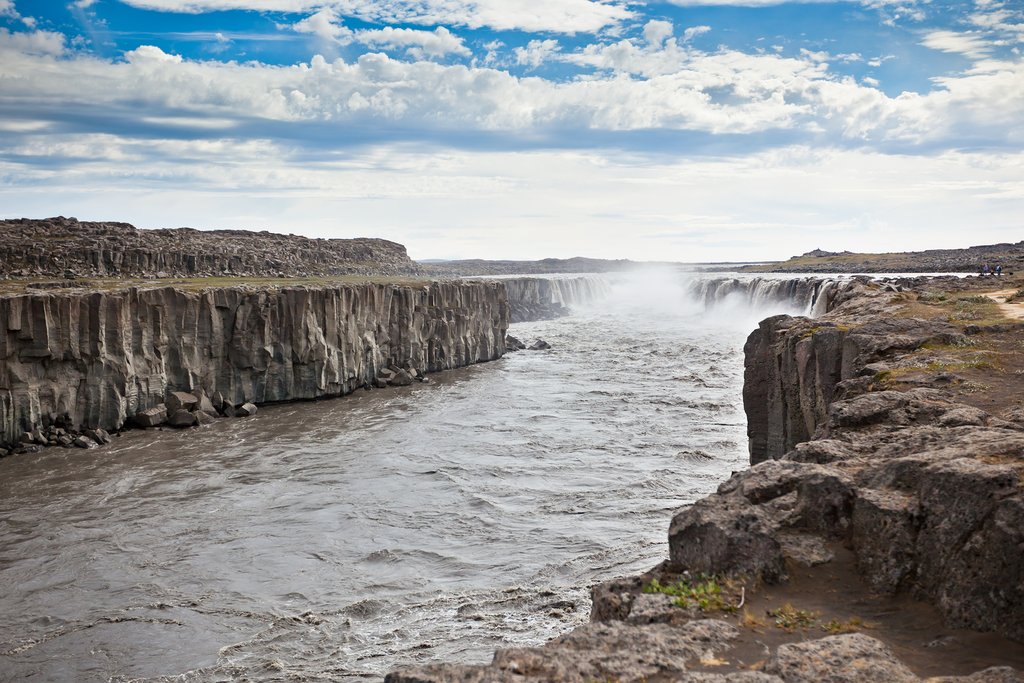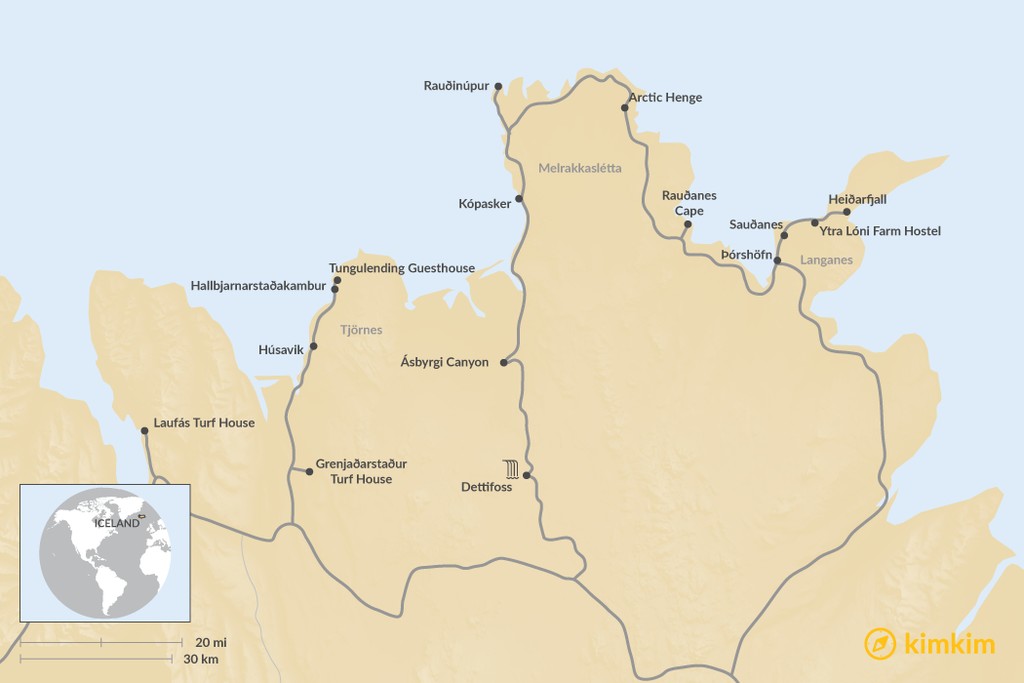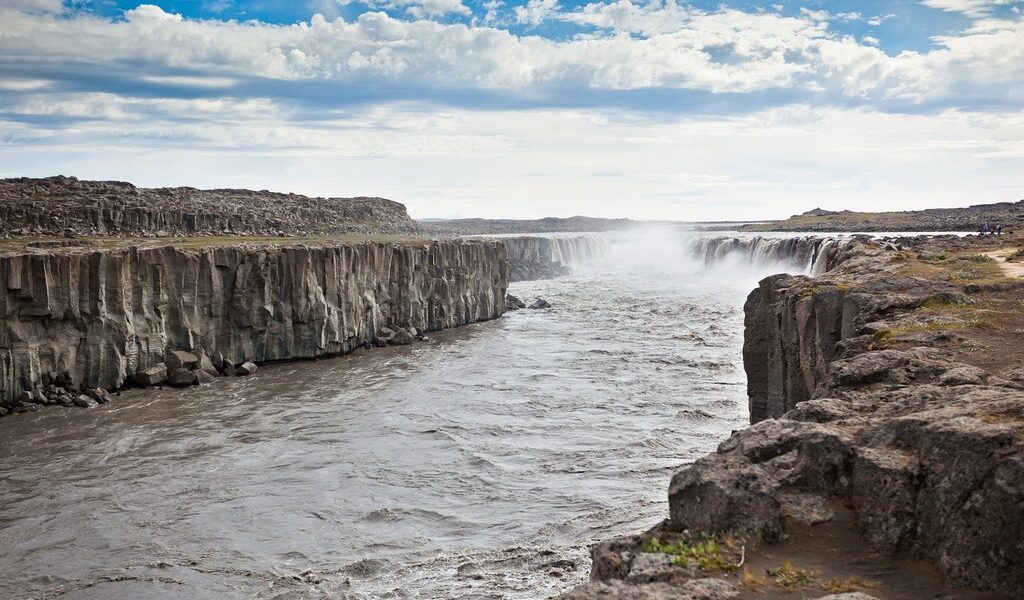
Northeast Iceland is more remote and wild than its southern counterpart. It’s known for abundant wildlife, from whales in Húsavik harbor to puffins on the Rauðanes Peninsula, as well as desolate cliffsides by the sea.
## Unveiling the Enchanting Northeast of Iceland
The northeastern region of Iceland presents a landscape unlike any other, a realm where the raw power of nature collides with serene beauty. This captivating area can be broadly categorized into three distinct peninsulas: Tjörnes, Melrakkaslétta (often simply called “Slétta”), and Langanes. Each peninsula boasts its own unique character, yet all share a common thread: a profound sense of remoteness and an abundance of wildlife. Northeast Iceland, far from the bustling tourist trails, is a veritable treasure chest overflowing with hidden gems and often-overlooked natural wonders, awaiting discovery by the intrepid traveler. Prepare to be mesmerized by the dramatic seascapes, the rugged shorelines teeming with life, and the sheer, unspoiled beauty that defines this extraordinary corner of the world. The air is crisp, the light is ethereal, and the feeling of being truly away from it all is palpable. This is a land where puffins reign supreme, where the Arctic Ocean whispers tales of ancient voyages, and where the spirit of Iceland resonates in its purest form. A journey through the northeast is not merely a vacation; it is an immersion into the heart and soul of this remarkable island nation.
## Exploring Tjörnes: A Geological Wonderland
Tjörnes serves as an exceptional introduction to the untamed and pristine northeast of Iceland. This peninsula, characterized by its isolated sea cliffs and sweeping panoramas of the Arctic Ocean, offers a glimpse into the geological marvels that have shaped this land over millennia. The journey often involves a drive through Tjörnes en route from Húsavik to Ásbyrgi, but it is crucial to resist the temptation to simply pass through. Instead, take the time to pause, breathe in the fresh sea air, and truly appreciate the remarkable geological prizes that this region holds. The layers of rock, the sculpted coastline, and the ever-present ocean create a scene of breathtaking beauty. Tjörnes is a place where time seems to stand still, where the forces of nature are on full display, and where the wonders of the earth reveal themselves to those who are willing to look. It is a landscape that inspires awe, invites exploration, and leaves an indelible mark on the soul.
### Discovering Húsavik: The Whale Watching Capital
Húsavik proudly holds the title of Iceland’s whale-watching capital, and for good reason. Daily excursions venture into the vast expanse of the northern Atlantic, offering unparalleled opportunities to witness these majestic creatures in their natural habitat. Beyond the thrill of spotting whales, Húsavik is also home to an informative and engaging whale museum, where visitors can delve deeper into the fascinating world of these marine giants. The history of Húsavik is as captivating as its present-day whale watching scene. In the 9th century, the Norseman Garðar Svavarsson sought shelter here during the first recorded circumnavigation of Iceland. He constructed rudimentary shelters to withstand the harsh Icelandic winter, an act that ultimately lent Húsavík its evocative name: the “Bay of Houses.” Imagine standing on the shores of Húsavik, gazing out at the same waters that Garðar Svavarsson navigated centuries ago, and feeling a connection to the rich tapestry of Iceland’s past. The blend of natural beauty, historical significance, and abundant wildlife makes Húsavik a truly unforgettable destination.
### Grenjaðarstaður Turf House: A Journey into Iceland’s Past
To truly understand the Icelandic way of life that persisted for nearly a thousand years, a visit to the turf house at Grenjaðarstaður is essential. These remarkable structures, constructed from simple materials like wood or stone and topped with a roof of turf and grass, were the standard form of dwelling in Iceland until the 19th century, when tin roofs began to gain popularity. The homestead at Grenjaðarstaður boasts a history stretching back a thousand years, although the existing houses are more recent, with the oldest sections dating back to 1865. Today, the turf house has been meticulously converted into a museum, offering a captivating glimpse into life in 19th-century Iceland. Stepping inside is like stepping back in time, surrounded by a wealth of historical artifacts, including charming old plates, kitchen utensils, teapots, and other household items that paint a vivid picture of daily life. Don’t miss the opportunity to peek into the adjacent old church, Grenjaðarstaðakirkja, erected in 1865. While the church itself is relatively modern, it houses a much older pulpit painting and church bells, adding to the historical significance of the site. The Grenjaðarstaður turf house is typically open to visitors daily from June through August, providing a perfect opportunity to immerse oneself in Iceland’s rich cultural heritage.
### Laufás Turf House: A Picturesque Manor of the Past
The Laufás turf houses, nestled in the scenic Eyjafjördur region, stand as exceptionally charming and picturesque examples of Iceland’s historical architecture. Once a grand manor and wealthy vicarage, these houses surpass the typical dwellings of their time in terms of elegance and refinement. People have inhabited the site of Laufás since the 9th century, and a church has stood here since the very dawn of Christianity in Iceland. The current church at Laufás, built in 1865, boasts a stunning pulpit dating back to 1698, a testament to the enduring craftsmanship of the era. Laufás welcomes visitors during the summer months, offering a chance to explore its beautifully preserved buildings and grounds. To reach Laufás from Húsavik, embark on a scenic one-hour drive west along Route 85, connecting to the Ring Road. Turn right onto Grenvikurvegur, and prepare to be transported back in time to a world of traditional Icelandic charm.
### Hallbjarnarstaðakambur: A Beach of Ancient Fossils
The expansive peninsula of Tjörnes occupies a strategic location in the northeast of Iceland, nestled between the Skjálfandaflói gulf and Öxarfjörður. At Hallbjarnarstaðakambur beach, an extraordinary geological treasure awaits discovery: immense layers of exposed fossilized seashells, dating back over 3 million years. Imagine walking along the beach, surrounded by these ancient remnants of a bygone era, each shell a tiny window into the earth’s distant past. Visitors are welcome to hike around the fossils and marvel at their intricate details, but it is strictly forbidden to disturb or remove anything from this protected land. To reach this remarkable site, drive from Húsavik, continuing along Nordausturvegur Route 85, and turn towards the sign for Tunguvellir. A short drive from the main road leads to the seashore, where the fossil-rich layers of Hallbjarnarstaðakambur await exploration.
### Dettifoss & Ásbyrgi Canyon: Nature’s Unfathomable Power and Beauty
The sheer power of Dettifoss waterfall and the awe-inspiring grandeur of the nearby Ásbyrgi Canyon make the journey to the northeast of Iceland an unforgettable experience. Both of these natural wonders are easily accessible from the Ring Road, providing convenient access for travelers. Alternatively, those exploring the northeast peninsulae via Road 85 can take the detour onto Road 864 to reach these iconic destinations. Countless hiking trails meander through the landscapes surrounding both Dettifoss and Ásbyrgi, offering ample opportunities for exploration and discovery. One could easily dedicate an entire day to hiking within the canyon, but a true exploration would ideally span two to three days, allowing for a deeper immersion into the area’s natural beauty. Dettifoss gained international recognition as a filming location for the film Prometheus, further adding to its allure. Furthermore, its proximity to two other stunning waterfalls, Selfoss and Hafragilsfoss, makes it a must-see destination for waterfall enthusiasts. Ásbyrgi Canyon, nestled within a nature reserve inside the Jökulsárgljúfur National Park, boasts a unique horseshoe shape and towering cliffs, creating a truly unforgettable spectacle. Be sure to visit Hljóðaklettar, a remarkable cluster of basalt columns, where echoes are known to reverberate across the valley in a mesmerizing cacophony. The experience of witnessing Dettifoss and exploring Ásbyrgi Canyon is nothing short of transformative, a reminder of the raw power and unparalleled beauty of the natural world.
## Melrakkaslétta: A Realm of Solitude and Untamed Beauty
Melrakkaslétta stands as one of the most overlooked regions in all of Iceland, a hidden gem waiting to be discovered. Its howling winds, desolate moors, and beaches strewn with driftwood create a landscape that is both captivating and haunting. The sense of remoteness is palpable, offering a true escape from the hustle and bustle of modern life. To reach Melrakkaslétta from Húsavík, embark on a 60-mile (97 km) eastward journey to Kópasker. If traveling from Egilsstaðir or Mývatn, follow the Ring Road to Dettifoss, then turn onto Road 85 and subsequently onto Road 870. From this junction, Kópasker is a mere 3 miles (5 km) away. As you traverse Melrakkaslétta, be prepared to be swept away by its raw, untamed beauty. The sheer vastness of the landscape, the dramatic interplay of light and shadow, and the profound silence broken only by the sounds of nature create an atmosphere of unparalleled serenity. Melrakkaslétta is a place where one can truly reconnect with nature and find solace in the solitude.
### West Melrakkaslétta: Coastal Villages and Avian Havens
On the western edge of Melrakkaslétta lies the charming village of Kópasker, home to the Earthquake Center, a fascinating institution dedicated to understanding the region’s seismic activity. Kópasker is also a haven for seabirds, with numerous nests belonging to species such as the redpoll, great skua, and razorbill. Keep an eye out for the elusive and elegant gyrfalcon, a rare and magnificent bird of prey that calls this region home. Venturing into northwest Melrakkaslétta, seek out the isolated cape of Rauðinúpur, characterized by its reddish ice age volcano. Nearby, you’ll find the isolated lighthouse at Hraunhafnartangi, a beacon of hope and guidance amidst the rugged coastal landscape.
### Arctic Henge: A Monument to Nordic Heritage
The Arctic Henge project, a monument dedicated to Nordic heritage, stands as a testament to human creativity and the enduring power of mythology. Erected in 1996 and inspired by the Eddic poem Völuspá, this ambitious artistic project comprises four triangular peaks, constructed from 72 smaller blocks, each inscribed with a dwarven name. Visitors can witness the mesmerizing midnight sun through the various vantage points offered by the structure. Although the Arctic Henge is still a work in progress, its imposing presence and symbolic significance make it a truly captivating site. To reach this unique monument, drive through the colorful and tiny Raufarhöfn Village on the Melrakkaslétta Peninsula.
### Rauðanes Cape: Geological Wonders and Coastal Beauty
Rauðanes, a picturesque inlet in Þistilfjörður in the northeast, marks the end of the Melrakkaslétta Peninsula. This area boasts a wealth of intriguing geological formations, including collapsed caves, natural arches, and towering rock stacks. The forces of nature have sculpted the landscape over millennia, creating a scene of unparalleled beauty and wonder.
### Rauðanes Point Cliff Hike: A Coastal Walk to Remember
For an unforgettable scenic walk along the coastline, embark on the Rauðanes Point Cliff Hike. Begin at the Rauðanes parking lot and follow the marked path towards the cliffs. Continue down a steep path along the cliffside, immersing yourself in the breathtaking views that unfold before you. The entire hike spans approximately 4 miles (7 km). The coastline is teeming with seabirds, including the adorable puffins during the summertime. The landscape is adorned with vibrant heather moorland and rugged rocky outcrops, creating a tapestry of colors and textures. Keep an eye out for Háabjarg, a towering 60-meter high cliff, the basalt bluffs of Lundastapar, the Gluggur stone bridge, and the Gatastakkur arch. After traversing the arch, you’ll encounter Stakkabásar beach, home to a small cave known as Hannesarhellir, or Hannes’ cave. The cave bears the name “Hannes” carved on one of its walls, a relic of a time long ago when sailors sought refuge here from a storm.
## Langanes: A Birdwatcher’s Paradise
Langanes, shaped like a goose’s head, is renowned as a paradise for birdwatchers, boasting endless bird cliffs and prime birdwatching spots. Avian enthusiasts should make a point of visiting the sea cliff of Skoruvikurbjarg, where locals have constructed a viewing terrace that extends over the water, offering an unparalleled vantage point of the nesting sites. From this unique vantage point, visitors can observe a diverse array of seabirds in their natural habitat, witnessing the intricate dance of life that unfolds along the cliffs.
### Þórshöfn: A Fishing Village with a Heart
The small township of Þórshöfn has flourished thanks to its thriving fishing industry, boasting a bustling harbor and a modest camping site. Stop by the Báran restaurant for a delectable afternoon bite, and be sure to try the local specialty, ocean quahog soup. The warm and welcoming atmosphere of Þórshöfn makes it a perfect stop along your northeast journey.
### Heiðarfjall: Ruins of a Cold War Past
At Heiðarfjall, you’ll discover curious ruins, including the remains of an old NATO radar station from the Cold War, which operated from 1954 to 1968. The remnants of this once-vital facility stand as a silent reminder of a turbulent period in global history. Nearby, you’ll find numerous abandoned settlements at Langanes, including Skálar fishing village, Heiðarhöfn, Læknistaðir, Skoruvík, Fagranes, and Saurbær. Make a stop at Sauðanes to explore the old church, which has been transformed into a museum, open from June to August.
## Navigating the Northeast: Getting There
Most of the major sites in the three peninsulas are accessible via Road 85, which stretches from Húsavík to Þórshöfn. By following this road, you can easily access the smaller routes that lead to the region’s many attractions. As with most areas in Iceland, it’s important to remember that distances on maps can be deceiving. Winding roads can often result in longer drive times than anticipated. For example, the drive from Húsavík to Laufás takes approximately 1 hour, while the journey from Húsavík to Ásbyrgi takes around 45 minutes. Crossing both the Tjörnes and Melrakkaslétta Peninsulas requires at least 2.5 hours, not including frequent stops to admire the scenery and explore the various attractions along the way.
## Accommodation: Where to Stay in Northeast Iceland
### Tungulending Guesthouse: Coastal Serenity and Caviar History
Tungulending Guesthouse, nestled on the coast of Skjálfandi Bay near Húsavík and in close proximity to the fossil cliffs, offers a truly unique accommodation experience. Once an old caviar factory, this charming guesthouse has been carefully renovated and refurbished, preserving its historical character while providing modern comforts. The location is simply breathtaking, situated directly on the shoreline. However, be aware that the access road can be a bit tricky, as it’s a steep 5-minute drive down to the water from the main road. The rooms are impeccably clean, with beds positioned right next to the shore, allowing guests to gaze out onto the water or listen to the soothing sounds of the waves as they drift off to sleep. Dinner often features fresh fish prepared daily, and the guesthouse also boasts a bar area serving beer and wine. This property comes highly recommended by local specialists.
### Ytra Lóni Farm Hostel: A Warm Welcome and Farmhouse Charm
The Ytra Lóni Farm Hostel in Þórshöfn provides a welcoming and comfortable rest stop at the end of your northeast journey. This charming hostel offers a range of amenities, including a barbecue, hot tub, bar, terrace, and free private parking. During the summer months, guests can visit the stables of the onsite sheep farm, gaining a glimpse into rural Icelandic life. Staying at this farmhouse is more akin to visiting an intimate country cottage than a traditional hotel, offering a personal and authentic experience.

B-1146

